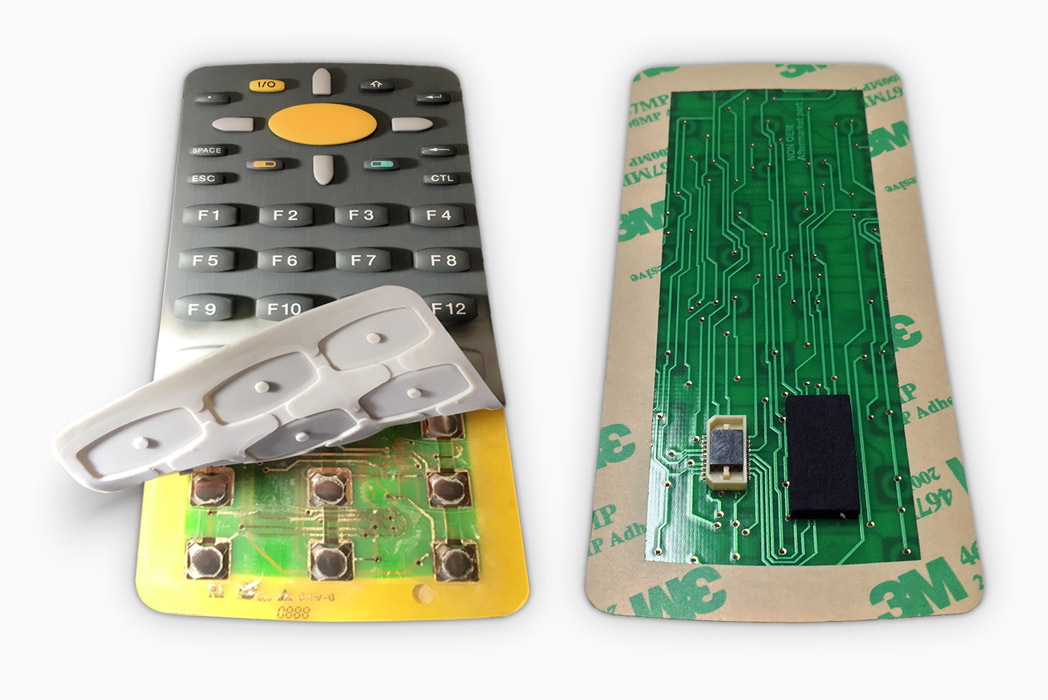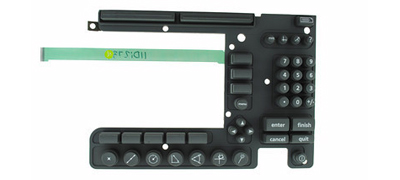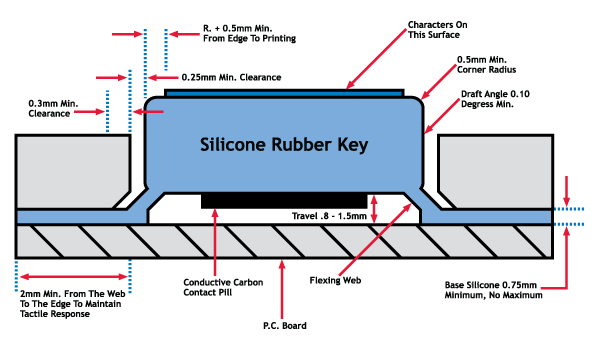Common challenges in producing Rubber Keypads and practical solutions
Exploring the Manufacturing Process Behind Rubber Keypads and Their Significance in Modern Tools
Rubber keypads are pivotal in the performance of modern-day devices. Their production procedure includes cautious choice of materials and precise techniques. Keypads are developed to boost customer interaction while ensuring toughness and integrity. Recognizing how these components are made exposes their significance across different applications. What aspects add to their efficiency, and how do these aspects influence user experience? The answers might reshape assumptions of this day-to-day technology.
Review of Rubber Keypads and Their Applications

Rubber keypads are versatile components commonly utilized in various digital tools, varying from consumer electronic devices to commercial equipment. Their style permits for a tactile action, making them an optimal selection for applications calling for individual communication. Generally found in items such as remote controls, calculators, and medical tools, rubber keypads help with simplicity of use and accessibility.
In industrial settings, they serve crucial features in equipment and control board, where longevity and resistance to environmental variables are essential. The non-slip surface boosts grasp, promoting integrity popular conditions. In addition, their lightweight nature and adjustable shapes enable producers to produce tailored solutions that fit specific demands. With advancements in technology, rubber keypads proceed to progress, including attributes like backlighting and enhanced level of sensitivity. In general, their flexibility and useful benefits add considerably to the performance of various tools throughout several sectors.
Products Utilized in Rubber Keypad Manufacturing
Keypad making counts on an option of products that boost both capability and longevity. The primary material made use of in the production of rubber keypads is silicone rubber, known for its exceptional resilience and flexibility. This material allows keypads to hold up against repeated pressing without shedding form or performance. Furthermore, thermoplastic elastomers (TPE) are typically used as a result of their simplicity of molding and capacity to provide a soft-touch feeling.
Coloring representatives, such as pigments, are incorporated to assure vibrant, lasting colors that boost aesthetic charm. Furthermore, ingredients like anti-UV agents and flame resistants might be combined right into the rubber to improve weather resistance and safety and security compliance. The choice of materials straight affects the keypad's responsive action, longevity, and overall efficiency in numerous gadgets. Ultimately, the mindful selection of these components is important for the manufacturing of premium rubber keypads that fulfill consumer and industry demands.
The Layout Refine of Rubber Keypads
When producing rubber keypads, the layout procedure plays a crucial function in figuring out functionality and individual experience. Designers begin by specifying the keypad's meant use, thinking about aspects such as the tool it will accompany and the target customer demographic. This initial stage includes sketching designs that focus on ergonomic facets, making certain the tricks are quickly accessible and suitably spaced.
Next off, developers concentrate on the responsive responses wanted from the keypads, which influences the selection of materials and essential shapes. Prototyping is vital in this stage, enabling designers to examine various designs for comfort and responsiveness.

Manufacturing Techniques for Rubber Keypads
The manufacturing process for rubber keypads involves a collection of specific techniques that ensure high quality and capability. At first, liquid silicone rubber (LSR) is frequently used due to its resilience and versatility. The process begins with blending the raw materials, consisting of silicone, colorants, and treating representatives. This mixture is after that injected right into mold and mildews created to form the keypads precisely.
Complying with injection, the molded keypads undergo curing, a home heating procedure that strengthens the product (Rubber Keypads). This is generally done in a press, ensuring the keypads accomplish the wanted firmness and resilience

Quality Control Actions in Manufacturing
To ensure that rubber keypads fulfill high criteria of quality and functionality, rigorous quality assurance steps are applied throughout the production process. These procedures begin with basic material evaluation, guaranteeing that just the highest-grade elastomers this website are made use of. During the manufacturing stage, operators conduct routine checks to keep track of specifications such as temperature, pressure, and mixing times, vital for achieving constant product high quality.
Post-production, each batch of keypads goes through detailed testing, consisting of tactile response assessments and durability tests to evaluate performance under various conditions. Visual assessments are likewise carried out to recognize any type of flaws, such as bubbles or inconsistencies in texture. In addition, conformity with industry criteria is confirmed, ensuring that the keypads meet safety and capability criteria.
The Function of Technology in Keypad Advancement
Modern technology plays a crucial function in the development of rubber keypads by allowing innovative production techniques that enhance precision and efficiency. In addition, cutting-edge material option enables improved longevity and responsiveness in keypad performance. These improvements not only simplify production yet additionally raise the general top quality of the last item.
Advanced Production Techniques
Advancements in production methods reinvent the production of rubber keypads, boosting both efficiency and accuracy. Technologies such as shot molding and 3D printing have transformed conventional procedures, enabling producers to produce intricate styles with minimized waste and enhanced turnaround times. Automation plays an essential role in this advancement, simplifying production line and reducing human error. Furthermore, computer-aided layout (CAD) software application allows for detailed customization, making certain that keypads satisfy specific customer requirements. Quality assurance actions have actually also progressed, including real-time surveillance systems that identify issues early in the manufacturing cycle. These developments not only enhance the sturdiness and performance of rubber keypads but additionally sustain the expanding demand for tailored options in numerous markets, from consumer electronic devices to automotive applications.
Innovative Product Choice
The advancement of manufacturing techniques has led the way for innovative product option in rubber keypad advancement. Advancements in polymer science have introduced materials that improve resilience, versatility, and tactile feedback. Makers now use polycarbonate elastomers (TPE) and silicone substances, which give exceptional resistance to put on and ecological variables. These products permit for the production of keypads that can withstand extended use while keeping aesthetic charm. Furthermore, the integration of coverings and additives improves functionality, such as enhancing grip and lowering friction. The selection of materials is vital, as it straight impacts the performance and longevity of keypads in numerous gadgets, from customer electronics to commercial tools. This ingenious method continues to shape the future of keypad layout and usability.
The Impact of Rubber Keypads on Individual Experience
Rubber keypads greatly affect customer experience with their boosted tactile feedback, which enables more accurate communication. Additionally, their resilience and durability add to constant efficiency with time, minimizing the need for frequent substitutes. This combination of functions makes rubber keypads a preferred selection in numerous applications, eventually influencing user satisfaction.
Enhanced Tactile Reaction
Enhancing responsive action significantly affects customer experience, especially in devices that count on keypads for interaction. Rubber keypads give an unique mix of softness and durability, permitting customers to really feel unique comments with each press. This responses enhances a feeling of control and precision, crucial in applications ranging from mobile phones to commercial devices. Individuals typically report higher contentment and performance when communicating with gadgets that include well-designed rubber keypads, as they promote quicker and extra precise input. Additionally, the ergonomic design of these keypads can lower finger tiredness, promoting longer usage periods without discomfort. Generally, the boosted tactile reaction provided by rubber keypads considerably adds to a more delightful and intuitive user experience in contemporary innovation.
Toughness and Long life
An essential aspect of user experience with rubber keypads hinges on their sturdiness and durability. These keypads are developed to hold up against considerable use, resisting damage that typically influences various other products. The durable nature of rubber warranties that keypads keep their capability and look in time, which is important for gadgets regularly used in various atmospheres. Customers take advantage check that of the reliability of rubber keypads, as they can sustain exposure to temperature, dampness, and dust fluctuations without weakening. This durability not just boosts customer fulfillment but additionally reduces the need for constant substitutes, ultimately contributing to cost-effectiveness for look at more info makers. Essentially, the durability of rubber keypads greatly influences the overall efficiency and user experience in contemporary gadgets.
Often Asked Concerns
How Much Time Do Rubber Keypads Typically Last in Tools?
Rubber keypads generally last between 5 to ten years, depending upon usage, ecological variables, and top quality of materials used (Rubber Keypads). Regular deterioration can reduce their life-span, impacting capability and customer experience with time
Can Rubber Keypads Be Custom-made for Details Applications?
Rubber keypads can indeed be customized for details applications, permitting alterations in size, color, shape, and appearance. This adaptability allows suppliers to produce customized solutions that meet varied customer needs and improve functionality in numerous tools.
Are Rubber Keypads Eco-friendly?
Rubber keypads are often not considered ecologically friendly because of their petroleum-based products. Nevertheless, advancements in sustainable manufacturing techniques and the advancement of bio-based alternatives are progressively boosting their eco-friendly influence in numerous applications.
What Prevail Issues Faced During Rubber Keypad Manufacturing?
Common issues dealt with throughout rubber keypad manufacturing include inconsistent material quality, mold and mildew problems, improper curing times, attachment failures, and obstacles in accomplishing precise tactile comments. These troubles can bring about decreased product performance and consumer frustration.
Exactly How Do Rubber Keypads Contrast to Other Sorts Of Key Changes?
Rubber keypads provide a softer feel and quieter procedure compared to mechanical buttons, which give tactile comments. Nevertheless, rubber keypads may wear faster and do not have the accuracy that some individuals prefer in high-performance applications.
The main product made use of in the production of rubber keypads is silicone rubber, recognized for its superb strength and versatility. When developing rubber keypads, the layout procedure plays a crucial function in figuring out functionality and customer experience. Rubber keypads considerably influence user experience with their enhanced tactile reaction, which enables for more specific communication. Users frequently report higher satisfaction and performance when connecting with gadgets that feature well-designed rubber keypads, as they assist in quicker and a lot more accurate input. A crucial facet of user experience with rubber keypads exists in their longevity and durability.